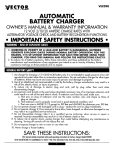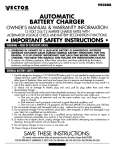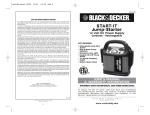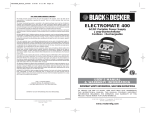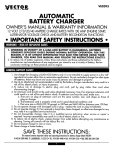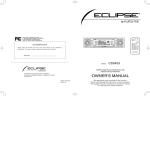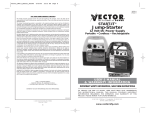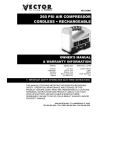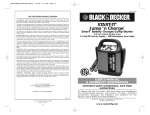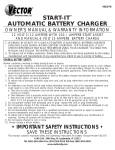Download Vector JUMP-START SYSTEM Owner`s manual
Transcript
VEC012B Jump ‘n Charge™ 12V Battery Charger and Jump Start System IF YOU SHOULD EXPERIENCE A PROBLEM WITH YOUR VECTOR PURCHASE CALL TOLL FREE (866) 584-5504. IN MOST CASES A VECTOR SERVICE REPRESENTATIVE CAN RESOLVE YOUR PROBLEM OVER THE PHONE. KEY INFORMATION YOU SHOULD KNOW: • BUILT-IN 12V BATTERY CHARGER • PORTABLE, CORDLESS, RECHARGEABLE • SAFETY WARNING ALARM SYSTEM • ULTRA BRIGHT LED AREA LIGHT BEFORE RETURNING THIS PRODUCT FOR ANY REASON, PLEASE CALL TOLL FREE (866) 584-5504 OWNER’S MANUAL AND WARRANTY INFORMATION THIS MANUAL CONTAINS IMPORTANT INFORMATION REGARDING SAFETY, OPERATION, MAINTENANCE AND STORAGE OF THIS PRODUCT. READ CAREFULLY BEFORE USE, AND RETAIN FOR FUTURE REFERENCE. 4140 S.W. 28th Way, Ft. Lauderdale, FL 33312 Toll Free: (866) 584-5504 IMPORTANT SAFETY INSTRUCTIONS WARNING - RISK OF EXPLOSIVE GASES 1. WORKING IN VICINITY OF A LEAD-ACID BATTERY IS DANGEROUS. BATTERIES GENERATE EXPLOSIVE GASES DURING NORMAL BATTERY OPERATION. FOR THIS REASON, IT IS OF UTMOST IMPORTANCE THAT EACH TIME BEFORE USING YOUR CHARGER, YOU READ THIS MANUAL AND FOLLOW THE INSTRUCTIONS EXACTLY. 2. To reduce risk of battery explosion, follow these instructions and those published by the battery manufacturer and manufacturer of any equipment you intend to use in vicinity of battery. Review cautionary markings on these products and on engine. GENERAL BATTERY SAFETY 1. Use the charger for charging a 12 V LEAD-ACID battery only. It is not intended to supply power to a low voltage electrical system other than in automotive applications. Do not use this battery charger for other types of batteries, these may burst and cause injury to persons and damage to property. 2. Use of an attachment not recommended or sold by the battery charger manufacturer may result in a risk of fire, electric shock, or injury to persons and will void warranty. 3. To reduce risk of damage to electric plug and cord, pull by plug rather than cord when disconnecting charger. 4. Use of an improper extension cord could result in a risk of fire and electric shock. When using an extension cord make sure: a. Pins on plug of extension cord are the same number, size, and shape as those of plug on charger. b. Extension cord is properly wired and in good electrical condition. Use of an improper extension cord could result in a risk of fire and electric shock. c. The wire size is AWG #16 (16 gauge) up to 100 feet and AWG #14 for distances over 100 feet. d. Pull extension cord by plug rather than cord when disconnecting from the charger. 5. Do not operate charger with damaged cord or plug - replace immediately. 6. Do not operate charger if it has received a sharp blow, been dropped, or otherwise damaged in any way; take it to a qualified service technician. SAVE THESE INSTRUCTIONS 1 7. Do not disassemble charger; take it to a qualified service technician when service or repair is required. Incorrect reassembly may result in a risk of electric shock or fire and will void warranty. 8. To reduce risk of electric shock, unplug charger from outlet before attempting any maintenance or cleaning. Turning off controls will not reduce this risk. 9. Do not expose charger to rain, snow or use when wet. 10. Never charge a frozen battery. PERSONAL PRECAUTIONS AND SAFETY 1. Another person should be within range of your voice or close enough to come to your aid when you work near a lead-acid battery. 2. Fresh water and soap should be nearby in case battery acid contacts skin, clothing or eyes. 3. Wear complete eye protection and clothing protection. Avoid touching eyes while working with a battery. Acid, acid particles or corrosion may get into eyes. Immediately flood eye with cold water (Eye Wash Station) for at least 10 minutes and seek medical attention immediately. 4. If battery acid contacts skin or clothing, wash immediately with soap and water. 5. NEVER smoke or allow a spark or flame in vicinity of battery or engine. CAUTION: Dropping a metal tool onto battery might spark or short-circuit the battery or other electrical part that may cause explosion. 6. Remove personal metal items such as rings, bracelets, necklaces, and watches when working with a lead acid battery. A lead-acid battery can produce a shortcircuit current high enough to cause a severe burn. CAUTION: Any changes or modifications not expressly approved by the party responsible for compliance could void the user’s authority to operate the equipment. NOTE: This equipment has been tested and found to comply with the limits for a Class B digital device, pursuant to part 15 of the FCC rules. These limits are designed to provide reasonable protection against harmful interference in a residential installation. This equipment generates, uses and can radiate radio frequency energy and, if not installed and used in accordance with the instructions, may cause harmful interference to radio communications. However, there is no guarantee that interference will not occur in a particular installation. If this equipment does cause harmful interference to radio or television reception, which can be determined by turning the equipment off and on, the user is encouraged to try to correct the interference by one or more of the following measures: - Reorient or relocate the receiving antenna - Increase the separation between the equipment and receiver - Connect the equipment to an outlet on a circuit different from that to which the receiver is connected - Consult the dealer or an experienced radio/TV technician for help 2 AC POWER CORD CONNECTION This charger is equipped for use with an extension cord. The extension cord must be first connected to the charger’s polarized plug. Only then should the extension cord be plugged into a properly installed 110/120VAC outlet in accordance with all local codes and ordinances. This battery charger plug is for use with 110/120VAC ONLY. DANGER: NEVER alter the extension cord or plug – if it will not fit an outlet, have a proper outlet installed by a qualified electrician. An improper connection may result in electric shock and will void warranty. INTRODUCTION AND FEATURES Use the Jump-Start/12 Volt DC Battery Charger System: • To jump-start any engine system with a standard 12 volt DC battery: boat; truck; car; airplane; RV; personal watercraft; snowmobile; garden tractor; gasoline engine generator, etc. • As a 12 Volt DC Power Supply: Operate 12 volt DC fans, inflators, fluorescent worklights, cellular phones (can quick-charge a cellular phone by using the phone’s 12 volt DC adapter cord), spotlights, TVs, portable radios, cassette or CD players, and more. • As a 12 Volt DC Battery Charger: The Jump ‘n Charge system has an easy-to-read series of LED (Light Emitting Diode) charge indicators that show when the unit is fully charged, or the level of charge in the battery. Charge level can be viewed when the charge status pushbutton is pressed. A 12 volt DC power accessory outlet is provided for use with appliances that can operate from a vehicle 12 volt DC accessory outlet. This allows maximum portability and utility when the Jump-Start System is used in remote locations. The Jump ‘n Charge system can be recharged from any standard 110/120 volt AC power source using a household extension cord. A built-in 12 volt DC appliance outlet and the appropriate DC/DC charging/adapter cord is used to recharge the battery from another 12 volt DC source. When pressed, the CHARGE STATUS button will show the battery power level status (from LOW to HIGH). The green LED full indicator illuminates when the unit is fully recharged and charging can be discontinued. An ON/OFF switch operates the built-in work/emergency light. FEATURES • • • • • • • • • Exclusive automatic ON/OFF power control ensures safety and resists sparking Reverse polarity warning alarm sounds to alert a reverse polarity connection Ultra bright LED emergency area light 12 volt DC charging cord for charging from vehicle High-density, 19Ah, sealed, non-spillable battery 12 volt DC power outlet for accessories and appliances Heavy duty welder-type cable and clamps Clamps power-on only with proper polarity connection Digital display shows charge rate, operating mode, fault codes and FUL when charged • Instant Start capability • Three-stage automatic rapid charging • Compensate for low AC from extension cord use 3 SMART BATTERY CHARGER The charger portion of the system is microprocessor-based and has three charge rate settings, controlled by one switch. (See Figure 1). 1. Stage One- Rapid Start Charge- delivers maximum charging amperage to “wake up” any serviceable 12 volt battery. When battery reaches a maximum safe predetermined voltage, the charger will automatically move into Stage 2 of the charging process. 2. Stage Two- Absorption Charge maintains the maximum possible charge at a constant, safe, predetermined voltage. During the phase, voltage absorption regulation charge, the charging voltage remains constant, while the actual charging current is reduced to allow for the maximum proper internal chemical energy transfer. 3. Stage Three- Top-Off Charge voltage is automatically maintained and reduced to a predetermined level while current is adjusted for a safe, effective 100% battery charge (step-down regulation mode). This is ideal for topping off batteries that have been in storage. Stage One BEEP Figure 1 BEEP Stage Two Stage Three OFF Amps CHARGING COMPLETE Size 4 amps smaller batteries as in lawn mowers, snowmobiles, motorcycles, etc. mid sized batteries as in watercraft and motorcycles 6 amps automobile batteries 2 amps BATTERY STATUS DISPLAY To check the battery status press the PUSH button ‘For Battery Low Level Battery Status’. 1. If all 4 indicators light (1 green light and 3 red lights) the battery is fully charged. 2. If 3 red indicators light, the battery is useable. 3. If 2 red indicators light, the battery is 1/2 discharged. Recharging is recommended. 4. If 1 red indicator lights, the battery needs a full recharge. 4 PREPARING TO CHARGE 1. Determine voltage of battery by referring to car owner's manual. 2. If it is necessary to remove battery from vehicle to charge, or to clean terminals, always remove grounded terminal from battery first. Make sure all accessories in the vehicle are off, so as not to cause an arc. 3. Clean battery terminals. Be careful to keep corrosion from coming in contact with eyes. 4. Add distilled water in each cell until battery acid reaches level specified by battery manufacturer. This helps purge excessive gas from cells. Do not overfill. For a battery without cell caps (maintenance free), carefully follow manufacturer's charging instructions. 5. Study all battery manufacturers' specific precautions such as removing or not removing cell caps while charging and recommended rates of charge. 6. Area around battery should be well ventilated while battery is being charged. 7. Make sure the initial charging rate does not exceed battery manufacturers requirement. CHARGER LOCATION 1. Locate charger as far away from battery as cables permit. 2. NEVER place charger directly above battery being charged; gases from battery will corrode and damage charger. 3. NEVER allow battery acid to drip on charger when reading specific gravity or filling battery. 4. NEVER operate charger in a closed-in area or restrict ventilation in any way. 5. Marine batteries must be removed and charged on shore. 6. Do not set a battery on top of charger. DC CONNECTION PRECAUTIONS 1. Connect and disconnect DC output clamps only after removing AC cord from electric outlet. 2. Never allow clamps to touch each other. 3. Attach clamps to battery posts and check for secure connection. This will hold clamps securely on terminals and helps to reduce risk of sparking. FOLLOW THESE STEPS WHEN BATTERY IS INSTALLED IN VEHICLE. A SPARK NEAR THE BATTERY MAY CAUSE A BATTERY EXPLOSION. TO REDUCE RISK OF A SPARK NEAR THE BATTERY: 1. Position AC and DC cords to reduce risk of damage by hood, door, or moving engine part. 2. Stay clear of fan blades, belts, pulleys, and other parts that can cause injury to persons. 3. Check polarity of battery posts. POSITIVE (POS, P, +) battery post usually has larger diameter than NEGATIVE (NEG, N,-) post. 4. Determine which post of battery is grounded (connected) to the chassis. If negative post is grounded to chassis as in most vehicles), see (5). If positive post is grounded to the chassis, see (6). 5 5. For negative grounded vehicle, connect POSITIVE (RED) clamp from battery charger to POSITIVE (POS, P, +) post of battery. Connect NEGATIVE (BLACK) clamp to vehicle chassis or engine block away from the battery. Do not connect clip to carburetor, fuel lines, or sheet metal body parts. Connect to heavy gauge metal part of frame or engine block. 6. For positive-grounded vehicle, connect NEGATIVE (BLACK) clamp from battery charger to NEGATIVE (NEG, N, -) ungrounded post of the battery. Connect POSITIVE (RED) clamp to vehicle chassis or engine block away from battery. Do not connect clip to carburetor, fuel lines, or sheet metal body parts. Connect to heavy gauge metal part of frame or engine block. 7. When disconnecting charger, turn switches off, disconnect AC cord, remove clamp from vehicle chassis, and then remove clamp to battery terminal. 8. See operating instructions for length of charge information. 9. Do not charge the battery while engine is operating. CHARGING THE BATTERY IN A VEHICLE 1. Check polarity of battery posts - For top-mounted battery posts, the Positive post (marked POS, P, +) usually has a larger diameter than the Negative battery post (marked NEG, N, -). For side-mounted battery terminals, the terminals are marked Positive -red and Negative -black. 2. Attach charger clamps to battery connections, as follows, ensuring a good connection (if there is a mistake, the Reverse Polarity Indicator will light): NEGATIVEGROUNDED VEHICLE: Connect the POSITIVE (RED) charger clamp to the POSITIVE (POS, P, +) battery post. 3. Connect the NEGATIVE (BLACK) charger clamp to the vehicle chassis, or the engine block (away from the battery). Do not connect the clamp to the carburetor, fuel lines, or sheet-metal body parts: connect only to a heavy gauge metal part of the frame or engine block. NOTE: The NEGATIVE-GROUNDED system is the most common in today's vehicles. 4. Set charger's Charge Rate 2/4/6 Amp to appropriate setting according to battery size. 5. Plug battery charger power cord into grounded AC power outlet and refer to page 8 for approximate charging times. 6. When charging is completed, disconnect cables and clamps in reverse order from which they were connected. CHARGING THE BATTERY OUTSIDE A VEHICLE: 1. Check polarity of battery posts- For top-mounted battery posts, the Positive battery post (marked POS, P, +) usually has a larger diameter than the Negative battery post (marked NEG, N, –). For side-mounted battery terminal connections the Positive terminal is red, the Negative terminal is black. 2. Attach a 24-inch (minimum length) #6 AWG insulated battery cable to the Negative battery post (marked NEG, N, -). 3. Connect the Positive (RED) battery clamp to the Positive battery terminal (marked POS, P, + or red). 4. Stand as far back from battery as possible, and do not face battery when making final connection. 6 5. 6. 7. Carefully connect Negative (BLACK) charger clamp to the free end of the battery cable connected to the negative terminal. Connect the charger's power cord to a grounded 110/120VAC power outlet. Set charger's charge rate to appropriate setting according to battery size. When charging is complete, disconnect cables and clamps in reverse order from which they were connected. OPERATION This Jump ‘n Charge system has three user selected charge rates; 2, 4 and 6 amps. Pressing the 2/4/6 Amp button selects the desired charge rate. The selected Charge Rate is indicated by a lit vertical LED bar. Once clamps are connected, AC is connected and there is no reverse polarity condition, press the 2/4/6 Amp button and the charger will begin charging at 2 Amps after the “battery condition pre-test” is complete. Pressing the 2/4/6 Amp button a second time will advance the charge rate to 4 Amps, a third time to 6 Amps. Pressing the button a forth time will turn OFF the charger output and display 000. To return to 2 Amps press the Charge Rate button. Digital Display Power Alternator Check 2/4/6 Amp Alternator Good Fault ON/OFF Polarized Plug Figure 3 - Charger Controls and Indicators 7 CHARGING TIMES The Charger will automatically adjust the charge rate as the battery charges and stops charging when the battery is fully charged. If you require some estimate of the time it takes to charge a battery refer to the chart below. PERCENT OF CHARGE 2 AMPS 4 AMPS 6 AMPS 75% 50% 25% 0% 7 HRS 3.5 HRS 2.5 HRS 13 HRS 6 HRS 5 HRS NR* 9 HRS 7 HRS NR* 12 HRS 9 HRS * Not recommended. The times shown in the chart above are approximate and refer to an average automotive battery. For smaller batteries, the charge time should be adjusted using the formula shown below and adding 1 hour to the time calculated. To estimate charging time for a discharged battery, divide the amp hour (AH) rating of the battery by the charge rate selected. This is the number of hours required to recharge the battery. For example, a 50 Ah (12 volt) battery is discharged (10 volts). Question: How long should it be charged at the 6 Amp rate? Divide the 50 Ah by 6. Answer: Approximately 8 hours. Always round up charge time by 10% to ensure full charge. In most cases, battery charge times will vary depending on age and condition of battery. Smaller batteries should be charged at the lower rate (2 Amps) and add an extra hour to charge time. NOTE: Deep cycle batteries may need longer charging time. It is recommended to repeat the charging cycle a second time beginning with the 2 Amp rate. CARE AND MAINTENANCE With minimal maintenance, the Jump ‘n Charge system will provide years of dependable service. • After each use, clean the battery charger clamps - be sure to remove any battery fluid that will cause corrosion of the copper clamps. • Clean the outside case of the charger with a soft cloth and, if necessary, mild soap solution. • Do not use charger if cords or clamps have been damaged in any way - call Vector Technical Support Department toll-free: (866) 584-5504 for replacement cords/clamps. TROUBLESHOOTING NOTE: Charger will NOT operate on batteries below 4.0 volts. If a 12 volt battery is below 4.0 volts, it is probably shorted, open or sulfated. Replace the battery. The following conditions may light the FAULT LED: • Charging too fast - Decrease Charge Rate - Press 2/4/6 Amp pushbutton to select lower rate. 8 Try charging another battery, if the FAULT LED does not light, then one of the above problems exists with the initial battery. Charger will not charge and the fan will not operate if there is a fault. Call Vector Technical Support toll free: (866) 584-5504. SULFATED BATTERY Batteries left in a discharged state for a long period of time are likely to become "sulfated". Sulfated batteries cannot accept a high rate of charge since the internal plates are coated with lead sulfate. To see if a battery in this condition can be "saved", take it to a service station or battery distributor for professional evaluation and service. INTERNAL SHORT CELL BATTERY • If the battery being charged has an internal shorted cell, the FAULT LED will light. • If FAULT LED light comes on, we recommend that you take your battery to a certified automotive service center for evaluation. BATTERY NOT ACCEPTING A CHARGE • Make sure that the charger is plugged into a "live" 110/120VAC outlet and POWER LED is lit. • Unplug charger and check battery connections - ensure there is a good connection with battery terminal and/or vehicle chassis. • Have the battery checked for sulfated condition (qualified service station or battery distributor). • Check that the correct charge rate has been selected for the battery being charged. • Ensure that enough charging time has been allowed for-check table for approximate charging times. VERY COLD BATTERY If the battery to be charged is extremely cold (in temperatures less than freezing - 0º C/32º F) it cannot accept a high rate of charge, so the initial charge rate will be slow. The rate of charge will increase as the battery warms. 9 CHARGER CONTROLS AND INDICATORS Figure 3 shows the charger control panel of the Jump ‘n Charge system, and consists of: Digital Display - Displays FUL when battery is fully charged, and displays the Fault Codes listed on page 9. Polarized Plug - use with most household extension cords. 2/4/6 Amp pushbutton - Selects 2/4/or 6 amps . ON/OFF pushbutton - Selects Off/On Power LED - when lit indicates AC is applied to charger. Fault LED - when lit indicates one or more abnormal conditions exist. Alternator Good LED - Lights when Alternator Check is complete and alternator voltage is good. NOTE: Each time the charger rate is changed, the charger sounds a beep. The only time the selected charge rate does not display at the full selected rate is when the battery is nearly full and charging at either steps two or three. The display will show a slow charge rate. To return to 2 Amp setting, press the 2/4/6 Amp button. When the battery is fully charged, “FUL” will be displayed . NOTE: Small 12 volt DC batteries such as those used in motorcycles, garden tractors, ATVs, jet skis, and snowmobiles can be damaged by high charge rates. ALWAYS select the 2 Amp setting to charge this type of battery. For slower charging time on larger batteries, select the 2 Amp setting. ALTERNATOR CHECK PROCEDURE NOTE: DISCONNECT THE 110/120V AC FOR THIS FUNCTION 1. 2. 3. 4. 5. 6. Connect positive (+) red clamp to vehicle battery’s positive terminal. Connect negative (-) black clamp to vehicle battery’s negative terminal. Press ON/OFF pushbutton to turn unit on. Press ‘Alternator Check’ pushbutton. The digital display will show bars. After approximately 15 seconds, Alternator Good LED will illuminate. If ‘Fault’ indicator lights, the alternator is not in good working condition and should be replaced. REPLACEMENT PARTS For replacement parts (bulbs, batteries, fuses, etc.), contact Vector Customer Service: (954) 584-4446 or toll-free (866) 584-5504. Battery Replacement It is recommended that the unit be returned to Vector Customer Service for battery replacement: Contact (954) 584-4446 or toll-free (866) 584-5504. 10 WARNING • Do not dispose of the battery in fire as this may result in an explosion • Before disposing of the battery, protect exposed terminals with heavy-duty electrical tape to prevent shorting (shorting can result in injury or fire) • Do not expose battery to fire or intense heat as it may explode PR BA 12 Volt DC Power Source PR This unit contains a maintenance-free, non-spillable, sealed lead-acid battery. This battery is fully recyclable and should be accepted at any location that accepts common automotive starter batteries. Examples of places that accept these batteries are: County or municipal recycling drop-off centers, scrap metal dealers and retailers who sell automotive replacement lead acid starter batteries. For more information on recycling this battery, call toll-free (877) 288-7722. BA Battery Disposal: ALWAYS RECYCLE Figure 2 - Jump ‘n Charge Controls and Indicators Reverse Connection Light Good Connection Light Battery Level Status PUSH Button Four Battery Level Status LEDs JUMP ‘N CHARGE CONTROLS AND INDICATORS Figure 2 shows the Jump ‘n Charge system control panel, and consists of: • Four Battery Level Status LEDs indicating Low to High levels of battery level status • Battery Level Status (PUSH) button lights LEDs above. • Good Connection Light indicates a good clamp and terminal connection. • Reverse Connection Light indicates the clamps are reversed. • 12 Volt DC Power Source Outlet for use with 12 volt DC appliances and recharge from vehicle battery 11 READ AND OBSERVE ALL CAUTIONS AND WARNINGS STEP-BY-STEP JUMP-STARTING INSTRUCTIONS This Jump ‘n Charge system is equipped with an automatic ON/OFF function that only allows Jump ‘n Charge energy to flow when proper connections are made to the battery and frame. The automatic ON/OFF function works in conjunction with an audible reverse polarity alarm and a large red LED light. If inadvertent reverse polarity occurs, the alarm will sound and the red LED will light. If this occurs, disconnect the black clamp (negative clamp) first, then the red clamp. Reconnect properly and a green LED will light . NOTE: The Green LED will not light if the battery’s voltage is less than 3 volts. Either wait or charge the battery until the voltage is higher than 3. CONNECT – Red clamp first, then black clamp. DISCONNECT – Black clamp first, then red clamp. 1. Turn OFF vehicle ignition and all accessories (radio, A/C, lights, cell phone, etc.). Place vehicle in park and set the emergency brake. 2. Remove booster clamps from clamp holder. 3. Procedure for jump-starting a NEGATIVE GROUNDED SYSTEM (NEGATIVE BATTERY TERMINAL IS CONNECTED TO CHASSIS). 3a. Connect positive (+) red clamp to vehicle battery’s positive terminal. 3b. Connect negative (-) black clamp to chassis or a solid, non-moving, metal vehicle component or body part. Never clamp directly to negative battery terminal or moving part. If the audible alarm sounds, the polarity is not correct. Reverse the connections. 4. Procedure for jump-starting POSITIVE GROUND SYSTEMS (NOTE: In the rare event that the vehicle to be started has a Positive Grounded System (positive battery terminal is connected to chassis) replace steps 3a and 3b above with steps 4a and 4b, then proceed to steps 5 through 7 below. 4a.Connect negative (-) black clamp to vehicle battery’s negative terminal 4b. Connect positive (+) red clamp to vehicle chassis or a solid, non-moving, metal vehicle component or body part. DO NOT CLAMP DIRECTLY TO POSITIVE BATTERY TERMINAL OR MOVING PART 5. A five (5) second delay is built into this jump-starter unit after the clamp connections are made. This delay is designed to reduce the possibility of sparking upon connection. We recommend waiting one (1) minute after making the clamp connections prior to attempting to start vehicle. 6. Start vehicle (do not turn key for longer than 3-5 seconds). 7. After vehicle starts, remove clamps (disconnect the frame or engine clamp first, followed by the battery cable) and replace them in the built-in storage holders. CAUTION: 1. If engine fails to start, leave ignition key turned off and disconnect the negative (-) clamp first, then the positive (+) clamp. Try again later – the engine may be flooded. 2. Recharge Jump ‘n Charge system after each use. 12 WARNING: Always disconnect the engine or frame jumper clamp first; followed by the battery jumper clamp. • There is a risk of explosive gases being released when batteries are charged or discharged. Failure to follow instructions may cause property damage, explosive hazard, and/or personal injury. • CHARGING/RECHARGING For maximum battery life, we recommend the Jump ‘n Charge be kept fully charged at all times. If the battery is allowed to remain in a discharged state, battery life will be shortened. NOTE: Recharging battery after each use will prolong battery life; frequent discharges between recharges will reduce battery life. 1. Use a common household extension cord to connect to 110/120 volts AC outlet. 2. Press ON/OFF pushbutton to turn the unit on. 3. Select 2/4/ or 6 amp charge rate. IMPORTANT: • • Make sure all switches are turned off during recharging Recharge unit fully after each use WARNING: Do not recharge for more than 3-4 hours maximum using 12 volt DC method OPERATION FOR DC CHARGING 1. Insert one end of the DC/DC charging adapter into the 12 volt DC accessory outlet on the vehicle or boat. 2. Insert the plug at the other end of this charging adapter into recharging port on the front panel of the unit. 3. When charging is completed, remove the power cord and store in a safe place. DC/DC CHARGER/ADAPTER This recharging method will NOT recharge the unit as effectively as recharging from a 110/120 volt AC outlet. The 12 volt DC recharging procedure is recommended only when it is necessary, as continued use of the 12 volt DC recharging procedure may shorten the battery’s system life. If unit is fully discharged, it is recommended that the vehicle being used for recharging be left running while the unit is being charged via the 12 volt DC method. 13 OPERATION AS A 12 VOLT DC PORTABLE POWER SUPPLY The 12 volt DC outlet provides 15 amps maximum current for 12 volt DC operated appliances. 1. Lift up the cover of the unit’s 12 volt DC accessory outlet (See Figure 2). 2. Insert the 12 volt DC plug from the appliance into the outlet on the unit. 3. Switch on the appliance, and operate as usual. CAUTION: DO NOT USE THIS UNIT TO OPERATE APPLIANCES THAT DRAW MORE THAN 20 AMPS DC. Table I - Using the unit as a 12 volt DC Power Supply Appliance Estimated Power Usage (Watts) Cell phone 1 Fluorescent light 4 Radio, fan, depth finder 9 Camcorder, VCR, spotlight 15 Power tools, bilge pump 24 Car vacuum 80 Operating Time (hours) 1-1/2 (talk time) 40 24 14 10 2 NOTE: All times are approximate and based upon a fully charged unit. EMERGENCY AREA LIGHT The Area Light is controlled by an ON/OFF switch. Make sure the area light is turned OFF when the unit is being recharged or stored. JUMP ’N CHARGE SPECIFICATIONS Model No . . . . . . . . . . . . . . . . . . . . . . . . . . . . . . . . . . . . . . . VEC012B Maximum Output Current (instant) . . . . . . . . . . . . . . . . . . . . . .450 Amps Weight . . . . . . . . . . . . . . . . . . . . . . . . Approximately 17.8 lbs. (8.0 Kg) Battery Type . . . . . . . . . . . . . . . . . . . . . . . .12 Volt, 19AH/20HR Sealed Rechargeable Non-Spillable, Lead-Acid Jumper Cables . . . . . . . . . . . . . . . . . . . . . . .Heavy Duty, Welding Cable Cables Clamps . . . . . . . . . . . . . . . . . . . . . . . 450 Amp, Copper Clamps Area Light . . . . . . . . . . . . . . . . . . . . . . . . . . . . . . . . . Ultra Bright LEDs Vehicle Test Voltage . . . . . . . . . . . . . . . . . . . . . . . . .Greater than 3 Volts Accessory Outlet . . . . . . . . . . . . . . . . . .Self-Resetting Breaker 20 Amps DC Charging Adapter . . . . . . . . . . . . . . . . . . . . . . . . . . . . .12 Volt DC Reverse Polarity Detection . . . . . . . . . . . . . . . . . . . . . . . . . .2 Volts (min) 12 Volt Outlet Output . . . . . . . . . . . . . . . . . . . . . . . . . . . . . . . . .15 Amp Charger Output . . . . . . . . . . . . . . . . . . . . . .12 Volt DC 6 Amp Maximum Alternator Check . . . . . . . . . . . . . . . . . . . . . . . . . . . . . .13.5 - 16.0 Volt 14 2 YEAR LIMITED WARRANTY PROGRAM This limited warranty program is the only one that applies to this product, and it sets forth all the responsibilities of Vector Manufacturing, Ltd., regarding this product. There is no other warranty, other than those described herein. This Vector Manufacturing, Ltd. product is warranted, to the original purchaser only, to be free of defects in materials and workmanship for two years from the date of purchase without additional charge. The warranty does not extend to subsequent purchasers or users. Vector Manufacturing, Ltd. will not be responsible for any amount of damage in excess of the retail purchase price of the product under any circumstances. Incidental and consequential damages are specifically excluded from coverage under this warranty. This product is not intended for commercial use. This warranty does not apply to accessories or damage to units from misuse or incorrect installation. Misuse includes wiring or connecting to improper polarity power sources. RETURN/REPAIR POLICY: Defective products, other than accessories, may be returned postage prepaid to Vector Manufacturing. Any defective product, other than accessories, that is returned to Vector Manufacturing within 30 days of the date of purchase will be replaced free of charge. If such a product is returned more than 30 days but less than two years from the purchase date, Vector Manufacturing will repair the unit or, at its option, replace it free of charge. If the unit is repaired, new or reconditioned replacement parts may be used, at Vector Manufacturing’s option. A unit may be replaced with a new or reconditioned unit of the same or comparable design. The repaired or replaced unit will then be warranted under the terms of the remainder of the warranty period. The customer is responsible for the shipping charges on all returned items after 30 days. During the warranty period, Vector Manufacturing, Ltd. will be responsible for the return shipping charges. LIMITATIONS: This warranty does not cover accessories, bulbs, fuses and batteries, defects resulting from normal wear and tear (including chips, scratches, abrasions, discoloration or fading due to usage or exposure to sunlight), accidents, damage during shipping to our service facility, alterations, unauthorized use or repair, neglect, misuse, abuse, failure to follow instructions for care and maintenance, fire, flood and Acts of God. If your problem is not covered by this warranty, call our Technical Support Department (954) 5844446 or toll free (866) 584-5504 for general repair information and charges if applicable. You may also contact us through our website at www.vectormfg.com. STATE LAW RIGHTS: This warranty gives you specific legal rights. Some states do not allow limitations on how long an implied warranty lasts or the exclusion or limitation of incidental or consequential damages, so the exclusions or limitations stated herein may not apply. This warranty gives the purchaser specific legal rights; other rights, which vary from state to state, may apply. TO REQUEST WARRANTY SERVICE FOR THIS PRODUCT: Contact Vector Manufacturing Technical Support by telephone, fax or mail. We suggest that you keep the original packaging in case you need to ship the unit. When returning a product, include your name, address, phone number, dated sales receipt (or copy) and a description of the reason for return and product serial number. After repairing or replacing the unit, we will make every effort to return it to you within four weeks. WARRANTY ACTIVATION: Please complete Warranty Activation Card and mail to Vector Manufacturing. Enter “VEC012B” as Model and “Jump ‘n Charge” as Product Type. All Vector Manufacturing, Ltd. products must be registered within 10 days of purchase to activate this warranty. Mail the completed registration form, along with a copy of the original sales receipt to: ATTN.: CUSTOMER SERVICE / VECTOR MANUFACTURING, Ltd. 4140 SW 28th Way, Ft. Lauderdale, FL 33312 PH: 954-584-4446 • TOLL FREE: 866-584-5504 • Fax: 954-584-5556. You may also contact us at our web site www.vectormfg.com. WARRANTY IS NON-TRANSFERABLE AND NON-REFUNDABLE. DS041504 15
















